|
|
|
Sort Order |
|
|
|
Items / Page
|
|
|
|
|
|
|
| Srl | Item |
| 1 |
ID:
109916
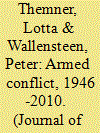

|
|
|
|
|
| Publication |
2011.
|
| Summary/Abstract |
In 2010, UCDP recorded 30 active armed conflicts (i.e. with a minimum of 25 battle-related deaths). This is a substantial reduction in relation to the 36 conflicts registered for 2009. A drop of this magnitude has only been reported four times previously in the post-1946 period. However, only in two of these instances was this part of a general downward trend. Thus no major inferences should be drawn, except perhaps that the reduction in conflicts in Africa seems to be part of a trend. At 30 in 2010, the number of active conflicts is at its lowest level since 2003. Furthermore, the number of wars (1,000 or more battle-related deaths) declined from six in 2009 to four in 2010. The most intense war in terms of fatalities was in Afghanistan. Eight of the armed conflicts listed for 2009 were not active in 2010, but during the year two new conflicts erupted - Mauritania and Tajikistan - both involving rebel groups that had previously fought in neighbouring countries. Only two peace agreements were concluded during the year. While this is one more than 2009, it is decidedly below the annual average for the post-Cold War period.
|
|
|
|
|
|
|
|
|
|
|
|
|
|
|
|
| 2 |
ID:
117019


|
|
|
|
|
| Publication |
2012.
|
| Summary/Abstract |
In 2011, the Uppsala Conflict Data Program (UCDP) recorded 37 armed conflicts with a minimum of 25 battle-related deaths. This significant increase from the 31 conflicts recorded in 2010 was primarily driven by an increase in conflicts on the African continent, and is only in part due to events tied to the Arab Spring which mostly led to other forms of violence than conventional armed conflict. The number of active conflicts still remains at a relatively low level compared to the peak years in the early 1990s, when more than 50 conflicts were active. The number of wars - conflicts leading to 1,000 or more battle-related deaths - increased to six; however, it is a considerably lower number than during the peak years of the early 1990s. For the second consecutive year, Afghanistan claimed the highest number of fatalities. Five armed conflicts listed for 2010 were not active in 2011, but during the year three new conflicts erupted - Libya, South Sudan and Sudan (Abyei) - and six conflicts already registered were restarted. Only one peace agreement was concluded during the year. Thus, the trend with low numbers of peace accords which started in 2009 continues.
|
|
|
|
|
|
|
|
|
|
|
|
|
|
|
|
| 3 |
ID:
122902
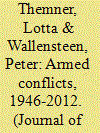

|
|
|
|
|
| Publication |
2013.
|
| Summary/Abstract |
In 2012, the Uppsala Conflict Data Program (UCDP) recorded 32 armed conflicts with a minimum of 25 battle-related deaths. This is a significant decrease from the 37 recorded in 2011. Overall, the 2000s has been the least conflict-ridden decade since the 1970s. A worrying finding, however, is that the number of internationalized intrastate conflicts continued to be at a high level for the fourth consecutive year. At six, the number of wars - conflicts leading to 1,000 or more battle-related deaths - remained the same as in 2011. In total, UCDP estimates that the conflicts that were active in 2012 caused between 37,175 (low estimate) and 60,260 (high estimate) battle-related deaths, with a best estimate of 37,941. The conflict that caused the highest number of fatalities in 2012 is the Syrian conflict, which led to between 14,830 (low) and 30,805 (high) battle-related deaths, with the best estimate being 15,055. Eleven armed conflicts listed in 2011 were not active in 2012; however, three new conflicts erupted during the year - India (Garoland), Mali and South Sudan vs. Sudan (common border) - and three previously registered conflicts were resumed by new actors. Lastly, 2012 saw an increase in the number of signed peace agreements which had been at a very low level over the past three years; four accords were concluded during the year, compared with one in 2011.
|
|
|
|
|
|
|
|
|
|
|
|
|
|
|
|
| 4 |
ID:
100050
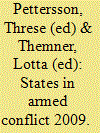

|
|
|
|
|
| Publication |
Sweden, Uppasala University, 2009.
|
| Description |
285p.
|
| Series |
Research report no 92
|
| Standard Number |
9789150621693
|
|
|
|
|
|
|
|
|
|
|
|
Copies: C:1/I:0,R:0,Q:0
Circulation
| Accession# | Call# | Current Location | Status | Policy | Location |
| 055493 | 303.6/PET 055493 | Main | On Shelf | General | |
|
|
|
|
| 5 |
ID:
108189
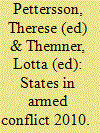

|
|
|
|
|
| Publication |
Uppsala, Uppsala University, Department of peace and conflict research, 2010.
|
| Description |
278p.
|
| Series |
Research report 94
|
| Standard Number |
9789150622492
|
|
|
|
|
|
|
|
|
|
|
|
Copies: C:1/I:0,R:0,Q:0
Circulation
| Accession# | Call# | Current Location | Status | Policy | Location |
| 056310 | 303.6/PET 056310 | Main | On Shelf | General | |
|
|
|
|
| 6 |
ID:
118517
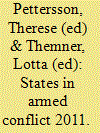

|
|
|
|
|
| Publication |
Uppsala, Department of peace and conflict research, 2012.
|
| Description |
290p.pbk
|
| Series |
Research Report 99
|
| Standard Number |
9789150623215
|
|
|
|
|
|
|
|
|
|
|
|
Copies: C:1/I:0,R:0,Q:0
Circulation
| Accession# | Call# | Current Location | Status | Policy | Location |
| 057108 | 355.02/PET 057108 | Main | On Shelf | General | |
|
|
|
|
|
|
|
|
|